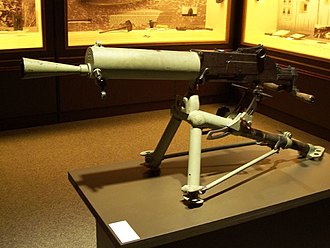Machine gun Schwarzlose
| Machine gun Schwarzlose | |
|---|---|

|
|
| general information | |
| Country of operation: | Austria-Hungary and its successor states, the Netherlands, Italy, Greece, Sweden, Poland, Romania, Bulgaria |
| Developer / Manufacturer: |
Andreas Wilhelm Schwarzlose , Austrian arms factory company in Steyr |
| Manufacturer country: | Austria |
| Production time: | 1905 to 1919 |
| Model variants: | M05, M07, M07 / 12, M07 / 24 |
| Weapon Category: | Machine gun |
| Furnishing | |
| Overall length: | 1067 mm |
| Weight: (unloaded) | 20 kg |
| Barrel length : | 526 mm |
| Technical specifications | |
| Caliber : |
8 × 50 mm R M93 (A / H), 8 × 56 mm R (A / H), 7.92 × 57 mm (D / CZ), 6.5 × 54 mm R (NL), 6.5 × 55 mm (S) |
| Ammunition supply : | Textile ammunition belts |
| Cadence : | 500 rounds / min |
| Fire types: | Continuous fire |
| Number of trains : | 4th |
| Twist : | right |
| Visor : | Sliding visor up to 2800 m |
| Closure : | delayed ground connection |
| Charging principle: | Recoil loader |
| Lists on the subject | |
The Schwarzlose machine gun was the standard machine gun of the infantry in the Austro-Hungarian army before and during World War I, as well as the army until 1938. The official military designation was: Machine gun 07/12 . The designer was Andreas Wilhelm Schwarzlose from Germany.
technology
It is one of the few proven machine guns with a fixed barrel and delayed mass breech . The energy that recoil chargers need for reloading comes directly from the recoil energy of the shot.
With the Schwarzlose machine gun, the return of the breechblock is delayed by a nearly closed knee joint; this is hinged to the front of the housing and to the rear of the bolt head. A lever attached vertically to the rear of the knee joint transfers the movement in an accelerated manner to the rear component of the breech, which is loaded by the closing spring and which also carries the firing pin. On the one hand, this contributes to the delay, on the other hand, a separate spring for the ignition can be dispensed with.
In order to ensure that the weapon functions properly and to limit gas leaks to the rear to a minimum, the gas pressure in the system must drop quickly, which was achieved with a relatively short run. In addition, the frictional resistance between the barrel and the bullet would slow it down during a longer run. To dampen the strong muzzle flash, the weapon has a noticeably large funnel at the end.
In order to avoid case tears, it was necessary in the early models to oil the cartridges using an oil container with a pump. Later this device could be dispensed with on newer models with a stronger extractor and a slightly modified lock. The cartridges are fed from the right through a belt and the weapon only shoots continuous fire. Like the Maxim MG , the Schwarzlose has water cooling, the non-moving barrel eliminates the Maxim's sealing problems.
commitment
In its original version, a copper-jacketed soft lead bullet in caliber 8 × 50 mm R Mannlicher , military. Designation M93, shot with a rounded tip. For export (until 1914), the MG was also supplied in 6.5 mm caliber; from 1931 the MG was also converted to the new 8 × 56 mm R rifle ammunition in the 1st Armed Forces (until 1938) . With only ten functional parts, the Schwarzlose machine gun was very reliable and was still used as booty by the Russian and Italian troops. The weapon was still in use by various armies during World War II .
Sweden
In 1914, the MG Schwarzlose M07 / 12 in caliber 6.5 × 55 mm / 94 became the Kulspruta m / 1914 in Sweden . (Ksp m / 14) introduced. The company Carl Gustafs stads gevärs developed in Eskilstuna manufactured approx. 1300 weapons under license until 1930.
Czechoslovakia
As the successor state of Austria-Hungary, Czechoslovakia took over a large number of weapons in its armed forces in 1918. From 1924 these weapons were converted to the caliber 7.92 × 57 mm and designated as M07 / 24 .
German Empire
After the smashing of the rest of the Czech Republic , the Wehrmacht took over the weapons captured there in 1939, especially since they were of the same caliber as the German rifles and machine guns, and used them primarily as heavy machine guns in the machine gun companies of the infantry divisions of the 5th and 6th wave of deployment , which were mainly equipped with Czech weapons. The associated one-horse machine gun cart was also taken over. Later replaced by other more modern weapons, reserve stocks were used by the Volkssturm towards the end of the war .
Exhibitions
In the permanent exhibition of the Army History Museum in Vienna , Schwarzlose machine guns can be viewed both in the version from 1907 and in the war version with tripod , shield and armored water cooler.
Individual evidence
- ↑ Johann Christoph Allmayer-Beck : The Army History Museum Vienna. The museum and its representative rooms. Salzburg 1981, p. 35.
- ↑ Evidence of the strength of the war (K.St.N.) No. 151a (T) of October 1, 1939


